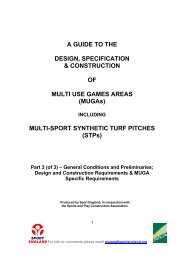View - North East Lincolnshire Council
View - North East Lincolnshire Council
View - North East Lincolnshire Council
Create successful ePaper yourself
Turn your PDF publications into a flip-book with our unique Google optimized e-Paper software.
BOC Immingham Dissolved Acetylene Project Environmental Statement: Vol. 2 Main Text<br />
Contaminated Land<br />
7.45 As discussed above, historical maps from 1888 to present day 9 indicate that the field has not been<br />
developed and so the ground is not expected to be contaminated as a result of historical land use.<br />
Ground Investigation (GI) works have been undertaken recently by ESG. The full GI report,<br />
including the result of sampling for potential contaminants, will not be available until after the ES<br />
has been finalised. However, ESG has confirmed that all soils encountered were natural, no<br />
made-ground was described in the borehole logs, there were no visual or olfactory indications of<br />
potential contamination and all soil vapour headspace readings were below instrument detection<br />
(i.e. there was no indication of volatile hydrocarbon contamination in the soil). This supports the<br />
view that the soil beneath the site is not likely to be contaminated, but this will be confirmed (or<br />
otherwise) once the full GI Report has been received<br />
Geology<br />
7.46 Published geology shows the development site to be underlain by Estuarine Alluvium comprising<br />
clay, silt and sand resting on Glacial Till (Superficial Deposits). These are underlain by the<br />
Cretaceous White Chalk Formation (Bedrock).<br />
7.47 Site-specific geology, based on preliminary borehole logs, provided by ESG, indicates that the<br />
development site is underlain by:<br />
� Estuarine Alluvium (Recent Deposits):<br />
- stiff, brown and orange-brown, slightly sandy CLAY from surface to between 1.1 and<br />
2.7 m bgl (0 to -0.88 m AOD), with a thickness of 1.1 to 2.7 m<br />
- soft, brown-grey, silty CLAY becoming very soft and with occasional shell fragments<br />
towards the base to between 6.4 and 8 m bgl (-4.48 to -6.54 m AOD), with a thickness of<br />
4.2 to 6.2 m,<br />
- either black, plastic, amorphous PEAT (BH1, BH4, BH5, BH7) to between 7.2 and 8.3 m<br />
bgl (-5.56 to -6.57 m AOD) with a thickness of 0.5 to 1 m, or<br />
- silty CLAY with PEAT (BH3, BH6, BH7) to 7 and 8.4 m bgl (-5.08 to -6.94 m AOD) with a<br />
thickness of 0.4 to 0.6 m;<br />
� Glacial Till (Superficial Deposits):<br />
- firm to stiff, brown-grey, slightly sandy, slightly gravelly CLAY to between 9.1 and 14.5 m<br />
bgl (-7.39 to -12.7 m AOD), with a thickness of 4.8 to 6.5 m where proved,<br />
- medium-dense, grey, slightly clayey, slightly gravelly, fine- to coarse-grained SAND to<br />
between 15.9 and 16.2 m bgl (-14.4 to -14.47 m AOD), with a thickness of 1.7 to 2.7 m<br />
where proved, and<br />
- stiff, grey, slightly sandy, slightly gravelly CLAY to between 18.2 and 18.4 m bgl (-16.47<br />
to -16.94 m AOD) with a thickness of 2 to 2.5 m where proved; and<br />
� Cretaceous White Chalk Formation (Bedrock):<br />
- CHALK proved to 25.45 m bgl (-23.72 to -24.04 m AOD).<br />
7.48 The intrusive investigation carried out on the adjacent BOC facility in 1990 proved a similar<br />
geological sequence.<br />
5100935.404 Environmental Statement August 2011 100




